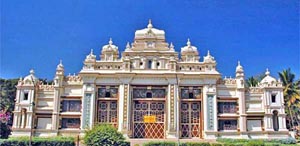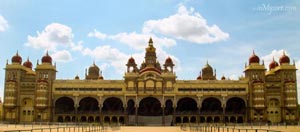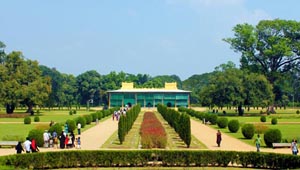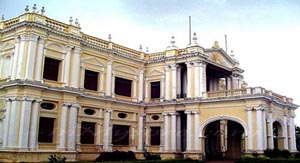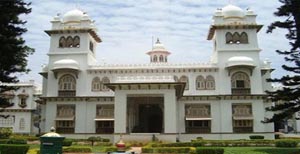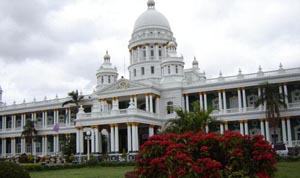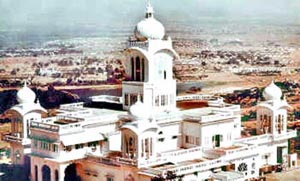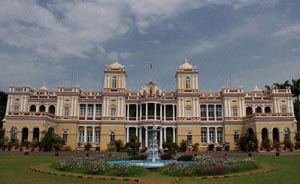Mysore Monuments - Historical Places to Visit in Mysore
Historical Monuments / Forts / Palaces / Places to Visit in Mysore
Here you can check list of names and information on famous historical forts / palaces / monuments / places to visit in Mysore, Karnataka, India. These famous monuments of Mysore are most visited and most sought after best tourist places. You can also find images of Mysore monuments / places / forts / palaces.
It is the architectural beauty of the palace that makes it one of the most magnificent structure in the city of Mysore. Notably, monument was made entirely on the basis of the Hindu architecture in a three storey structure. During the year 1900 the monument was renovated by adding an outside facade in the form of a function hall to the palace. The hall has three entries with each one of them is crafted on the designs of temples and others religious architectures.
Mysore Palace has hybrid architectural style, i.e. the structure of the palace is the mixture of several designs. The style on which the construction of Mysore Palace was based is termed as Indo-Saracenic style. Mysore Palace is a mixture of Hindu, Islamic, Rajput and Gothic architectures. It is a three storied building, having marble ceilings and one 145 foot tall tower. The palace is fenced by a big garden. The building of the palace is developed with grey brickwork and deep pink marble roofs.
Historical reports suggested that the palace was made during the year 1784 under the rule of King Tipu Sultan. The completion of the palace was recorded during the early period of the 18th century in the Wodeyars rule under the leadership of Hyder Ali. The palace has a collection of memorabilia of King Tipu Sultan. It also had figures and paintings relevant to the European style along with the Persian manuscripts within the interior of the palace.
The Jayalakshmi vilas mansion built by the Maharaja Chamaraja Wodeyar, for his eldest covers an area of 6 acres with 125 rooms, 300 windows, and 287 imprinted doors with great modification. This three department building consists of a dancing hall, Kalyana Mantap and luminously festooned rooms. The dancing hall in the mansion has a inexpressive wooden flooring and its covering or the roof is adorned with highlighted glasses.
The mansion houses since 1965 the Postal Training Institute of the Department of Posts, Government of India. It was built in 1902 on an area of 38 acres on an elevated place. It became popular as Karanji Mansion because of its proximity to the Karanji Tank. It was constructed at a cost of Rs. 4,27,610. The Postal Department is maintaining the Mansion well. Apart from training its staff, it has set up a museum here depicting the Postal history of the country.
The palace which can be found in the hills of Chamundi, with a extensive garden, which has been set around the surroundings of the palace. The palace was however premeditated by E.W. Fritchley. He was the designer from Mumbay, and was completed by B. Munivenkatappa. The architecture of the palace is built in the Renaissance which is also well thought-out to be the mirror of the St. Paul's church or Cathedral which is in London, stupendously the fundamental dome.
The architecture of the Rajendra Vilas Palace is designed in the Indo-Sarcenis technique, and it has four Chhatris and also the innermost dome. The Chhatris is built in the structure giving the mirror of the Rajasthani design. The tower is placed on the sky scraping position and the dome is grooved and showcases a lantern. The verandah is on the north and has a design of semi circular, and giving the entire view of the city of Mysore.
Cheluvamba Mansion is built in a semi classical design of the modern India architecture. This mansion was built for the princess and all of its royal touches are seen everywhere in its structure, in stone and wooden works. Its crafts man ship is really appreciable. This is constructed in a large rectangular shape. It is a single storied mansion. This mansion has its specialty marks. It has a very beautiful 2 doomed towers on its main entrance. This make it differentiable from the other palaces found here built of the same time.
- Bangalore Monuments
- Bagalkot Monuments
- Belgaum Monuments
- Bellary Monuments
- Bidar Monuments
- Bijapur Monuments
- Chitradurga Monuments
- Coorg Monuments
- Dakshina Kannada Monuments
- Gadag Monuments
- Gulbarga Monuments
- Hassan Monuments
- Mysore Monuments
- Raichur Monuments
- Uttara Kannada Monuments
- Yadgir Monuments
- Andaman Nicobar Monuments
- Andhra Pradesh Monuments
- Assam Monuments
- Bihar Monuments
- Chhattisgarh Monuments
- New Delhi Monuments
- Goa Monuments
- Gujarat Monuments
- Haryana Monuments
- Himachal Pradesh Monuments
- Jammu and Kashmir Monuments
- Karnataka Monuments
- Kerala Monuments
- Madhya Pradesh Monuments
- Maharashtra Monuments
- Odisha Monuments
- Punjab Monuments
- Rajasthan Monuments
- Tamil Nadu Monuments
- Telangana Monuments
- Uttar Pradesh Monuments
- West Bengal Monuments
